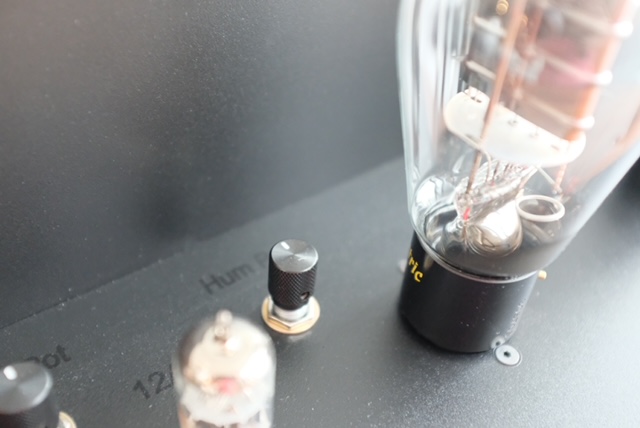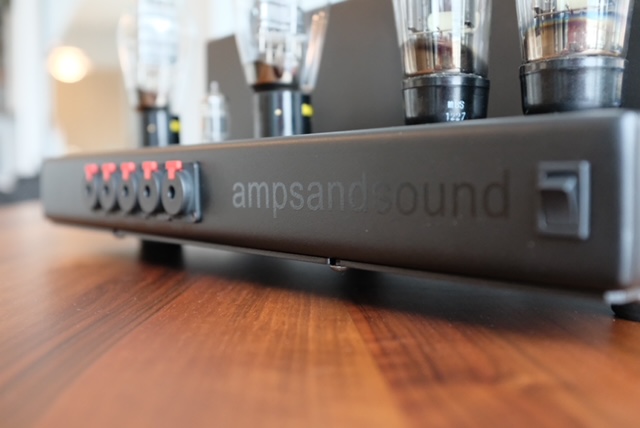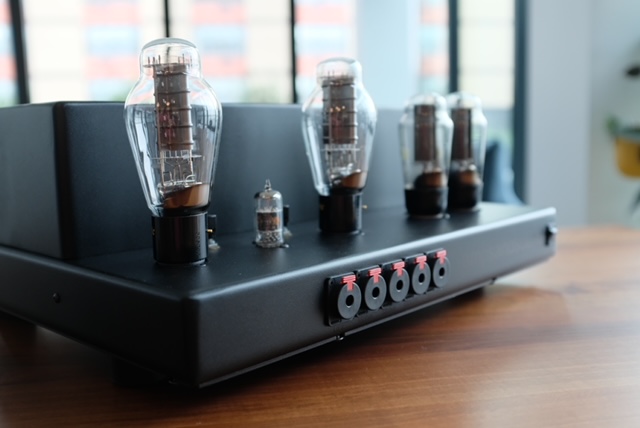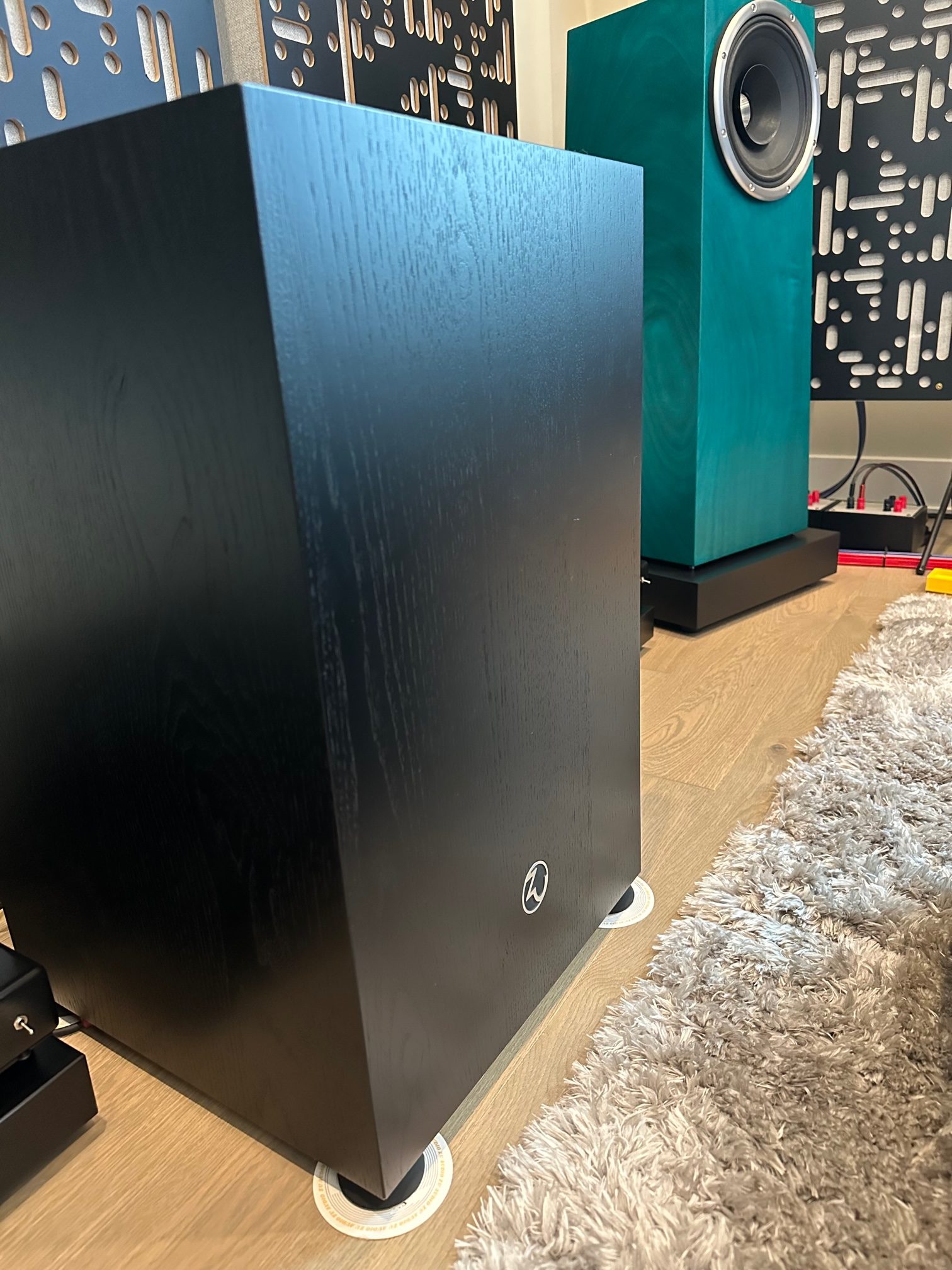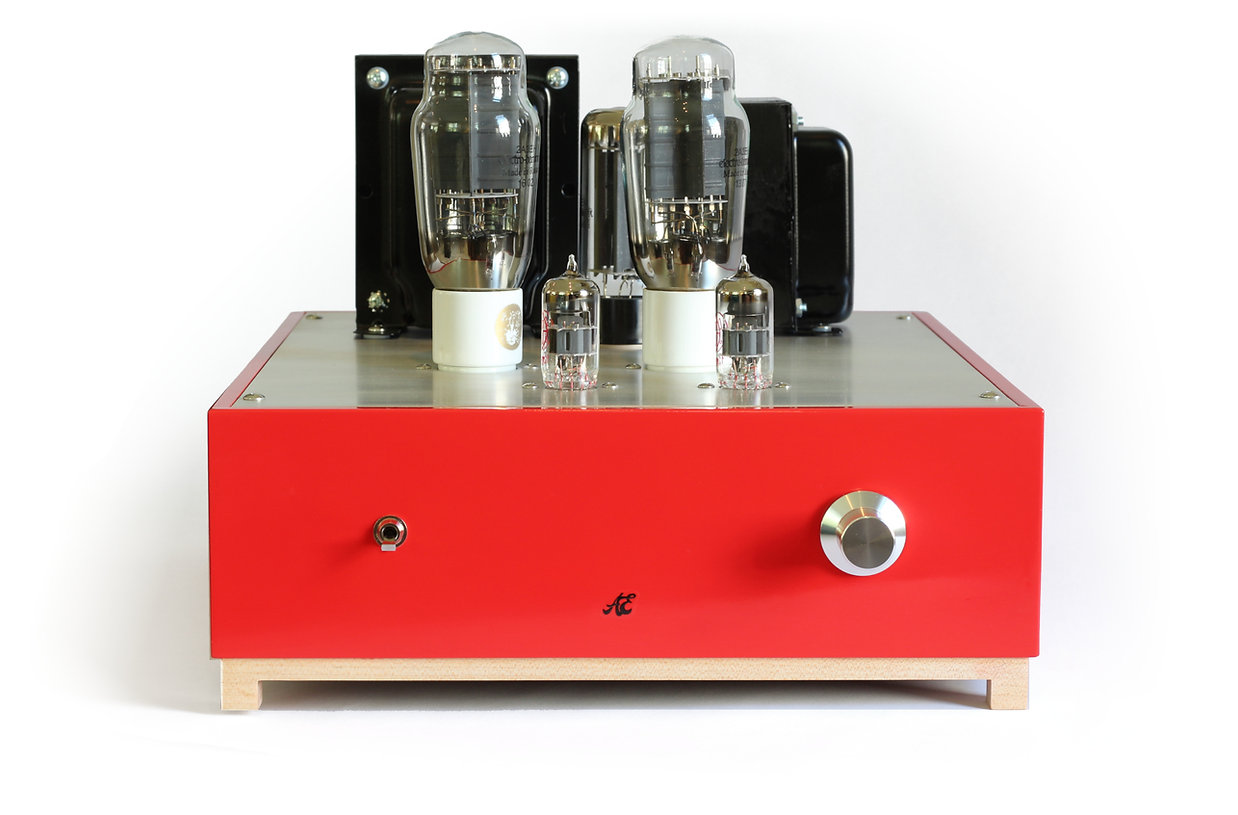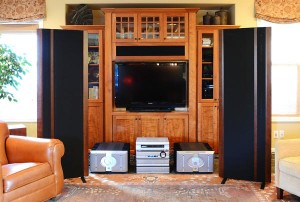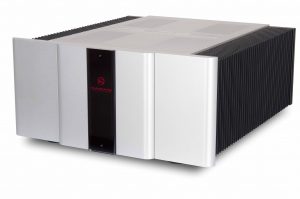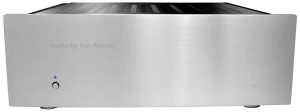Black on Black Red October with Western Electric 300Bs and U52s
ampsandsound continues to surprise and delight me. Last year it was with the Rockwell, which showed me what a DHT amplifier built around a less well known tube could do. ampsandsound also rolled out the new Agartha and converted their entire lineup (with the exception of the Rockwell) to novel (9 pin) input tubes. For a small company, Justin Weber (the owner of ampsandsound) is making big changes at a speed rarely seen in high end audio. Good news for me and everyone else, he had a few more surprises in store and one of them was the Red October.
The Red October, is a no holds-barred 300B single-ended tube amplifier. It is built on his rolled steel chassis with beautiful point-to-point and turret board construction. While the amplifier itself is built on a single chassis, it is a true dual mono design. Each channel has its own separate power supply, and the only shared components are headphone jacks, outputs, and inputs. Everything else is duplicated to ensure listeners have the best performing amplifier ampsandsound can build (and they build incredible amplifiers).
This summer, Justin reached out to me and offered to send me a Red October for review. He also was nice enough to send the Sennheiser HD800S, as well as the new production Western Electric 300B vacuum tubes. He also supplied JJ 5U4Gs, and a variant of a NOS 12AT7 for the input tube.
Arrival and Unboxing
Like all of ampsandsound amplifiers, the Red October arrived in a Seahorse flight case. It weighed nearly 100 pounds, and the FedEx guy gave me a nice but aggravated look when he showed up at my door with it. Wheeling the amplifier inside, I made quick work of the unboxing process. Justin sent me his personal unit which has a black-on-black color scheme. It has two different textures of black along with black silk-screened logos and tube socket names.
While the case adds shipping weight the amplifier itself is probably north of 80 pounds. That is thanks to four transformers (two output, two power supply) and four chokes. Justin has spent several years perfecting his power supply design and the result is a power supply with massive reserves and an incredibly low ripple. He has achieved this without a single integrated circuit and has relied on the techniques that were used to build some of the best tubes amps of the 50s, 60s, and early 70s.
The other thing that contributes to to the Red October's incredible weight is the chassis itself. It is composed of cold rolled steel, that simply does not and will not flex. His amplifiers are easily the most solidly built components in my equipment rack. My understanding is the chassis alone is in the 20 pound range.
As I mentioned above, the amplifier has room for five tubes: two 300B tubes, one input tube (which can be any 12A_7 variant, but is labeled for a 12AX7), and two rectifier tubes, (which is labeled as 5U4Gs but can also be used with 5AR4s if you prefer a more solid bottom end).
The front of the amplifier consists of a power switch and five single-ended headphone inputs. These inputs represent different impedances, and are a key part of the ampsandsound brand. ampsandsound's flagship headphone amps, of which the Red October is one of, all have 8 ohm, 16 ohm, 32 ohm, 100 ohm, and 300 ohm outputs. These impedances are not simply pulled off of the the same output and achieved via a voltage divider network, instead they are pulled directly off of the transformers as separate windings. The result is a simpler and more pure circuit. This amplifier can marry with pretty much any production headphone in the world, and has a nearly endless combination of sound customizations, as each impedance imparts its own flavor onto the output.
Around the back of the amplifier you will find IEC in, two fuses, and left and right speaker outputs (with both a 8 ohm and 16 ohm output.) You will also find a speaker selection switch, which will mute the 8 ohm speaker or headphone output respectively.
On top of the amplifier you will also see two knobs, these knobs are called hum pots. Direct heated triodes like the 300B can hum if the AC noise is not cancelled. The hum pot allows for a fine adjustment to ensure you cancel as much noise as possible. In theory this adjustment is tube dependent however, most of the time it's power dependent. Once set it is likely that it will not have to be changed unless you change the power that the amplifier is connected to (for example, moving it to another home/room or connecting a new power conditioner in front of it).
The Red October employs zero (or no) feedback. Many people who love single ended amplifiers love the sound of a zero feedback since it has a purity to it. I personally agree and love the sound of a zero feedback amplifier when well executed. We will talk more about this below.
Let's talk about Tubes and Power
When purchased from Justin with the stock tube configuration this amplifier will be sold with a JJ 12AX7, JJ/Gold Lion 300Bs, and JJ 5U4Gs. To be clear there is nothing wrong with this configuration and I advise any new tube amplifier owner to spend time with the stock tubes for at least three months before exploring other options. You may honestly find that you never need to explore more.
The ability for this amplifier to take nearly any 12A_7 tube type really opens the possibilities for some interesting combinations. Personally, I really liked the Red October with 12AT7 and 12AU7 variants since it was quieter and a bit more dynamic. Though those who need raw power for hard to drive headphones like the Susvara or the Abyss 1266 should probably consider sticking with either a 5751 or a 12AX7. Using a 12AX7 will yield you between 6 and 8 watts per channel depending on the impedance tap, so power will never be an issue. My favorite input tube with the Red October was the Raytheon 5751 and the GEC a2900 (a 12AT7 variant). I do want to say though that the JJ 12AX7 is a very underrated tube though and I think once broken in they sound quite good.
Unlike the Nautilus, which can take anything from a 6L6GCs all the way to KT88s, the Red October is only built to use one power tube, the 300B. In my humble opinion, the best 300B is the Western Electric 300B, and the re-issues coming out of Western Electric using the original tooling, and purer metals not only look like the original but sound really darn good. I cannot say that I have heard an original Western Electric 300B, but I can say that the reissues are the nicest new production tube I have ever held and listened to. My suggestion for anyone who purchases this amp is to simply save the money and buy the re-issued Western Electric tubes. They are not a must have, but they will give you the pleasant feeling of knowing you cannot do better.
For rectifier tubes, the JJ 5U4Gs are really quite good. If you want the look you can go find a pair of NOS coke bottle black plate 5U4G rectifiers from an American brand, or you can explore 5AR4s. The benefit of a 5AR4 is that in comparison to a 5U4G it drops far less voltage. The result is hotter plates, and less sag (which translates into a tighter more accurate bottom end). I always go back and forth between the sound of 5U4Gs and 5AR4s, its a subtle difference but if you know what to look for it is easy to tell what is in the amplifier. I would suggest anyone who owns the amplifier should pickup new production 5AR4s and give them a try, if you like them then maybe go look for NOS variants.
For this review, the amplifier ran the GEC a2900 as an input tube, a pair of Western Electric 300Bs, and the stock JJ 5U4G rectifiers.
Review System
- Source: Roon Core
- Amplifier: ampsandsound Red October (with volume put set to 100%)
- DAC/Pre: DCS Rossini
- Power Conditioner: PS Audio P12
- Speakers: Zu Audio Soul 6
- Headphones: Sennhieser HD800S
- Cabling: Wireworld Eclipse, Strata, and Aura
- All equipment had been burned in for a minimum of 200 hours before listening.
Headphone Listening
Turning on the Red October is simply a very satisfying experience. You watch the amplifier come to life, you watch it warm up, you hear it warm up depending on the tubes, and once the noise settles you know you're ready to listen.
Sitting back with the HD800S, I clicked play on Melody Gardot's Live in Europe album, as I listened to the first track "Mira" I was shocked at the space that was presented. To be clear the HD800S in general are known for their speaker-like presentation but I have never heard them sound like this. The soundscape and image were pointed and crystal clear and headphones were not sharp or treble heavy as they can become with other equipment. The Red October truly keep the headphones neutral, and even maybe ever so slightly neutral warm. As Melody sang, I found myself captivated by her every word. This was quite different then the Nautilus, which while exciting and engaging, it was almost dry in my memory in comparison to the richness of the Red October.
300Bs amplifiers especially in the middle and low end in have tendency to emphasize the mid-range and will fall off in the treble and in the bass region. This is why some stay away from 300B amplifiers. However a well executed one is remarkably linear. The Red October is incredibly well executed. While the mid-range was the star of the show, the bass region was alive, well, and thunderous. Listening to Soffi Tucker's "Good Time Girl" a favorite of mine, the deep bass snapped forward and backward providing me with all that I could want without ever sounding bloated or overdone.
It would not be a review without listening to Mika's live at Brooklyn Steel, whether it was "Popular Song," or "Tomorrow" the HD800S transformed itself into a concert hall powered by the Red October. Bass, presence, space, clarity, were all on the table, with no harshness and no grating moments. The dynamics really impressed me as well.
I spent some time experimenting with the different headphone outputs, since the HD800s are a 300 ohm headphone, the natural decision would be to listen to them off of the 300ohm tap. While this tap did create the tonally accurate presentation, and clearly had the most energy, I found that it was also the most noisy. The noise was not bothersome while listening to music at mid-volume but it was unfortunately not dead silent. This is a consequence in my system of not using the built in volume pot of the Red October, as the DCS does its volume control in the digital domain, and is always outputting the full 2 volts even at lower volumes. I also personally like a leaner but more detailed presentation. As a result I ended up listening to them on the 8 ohm tap, which was dead silent and sounded exceptional with the HD800s. It also provided the largest sound stage.
Speaker Listening
The Red October is a headphone amp first and foremost, it is not dedicated speaker amplifier. However, it can be connected to 8 ohm or 16 ohm speakers via the binding posts on the back of the amp, and as long as the speakers are efficient (think 98dB/W and up) you should be in good shape. I connected the Red October to the Soul 6 (99dB/w with a easy 8 ohm load) and when I pressed play my jaw dropped.
The Red October expressed every characteristic that I heard from it on headphones through my Soul 6 loudspeakers. It brought a sense of presence into my room that I have never had before. It was tonally intoxicating, everything sounded so real, and it presented the Soul 6 with a top end that I have simply never heard before, Silky smooth, with a mid-range to simply die for. The bass presentation really stood out for me though, It was bombastic, powerful, fun, and went low enough in my room that I decided to turn off my subwoofer for the duration of the review.
At 99 dB/W, I had no issue cranking the Soul 6 to high volumes while being powered by the Red October, they never collapsed, and they didn't show any obvious signs of compression or strain. I was truly taken back at the performance. So much so that when I re-hooked up my Zions I actually had to wonder which one I liked more. Ultimately the Zions are a better speaker amplifier, but the Red October does so much right that in all honesty if I did not already own the Zions I would consider purchasing the Red October as the ultimate headphone/speaker amplifier and call it a day. It really is that good.
Whether it was Soffi Tucker, Melody Gardot, Modest Mouse, or Red Hot Chili Peppers the performance with the Soul 6 was breathtaking. If you are a fan of metal, you can and should pass. Single-Ended Tube amplifiers are good at many things, and while the Red October is fast Master of Puppets by Metallica can sound better with solid-state amplifiers. For literally any other genre the Red October is simply awesome.
Comparing it to the rest of the ampsandsound line
The Red October is positioned as, and the flagship headphone amplifier from ampsandsound. In my opinion it is simply better then every other amplifier in the line as long as you understand what it is. It is a Direct Heated Triode, and while it is quiet, it is not silent at all times. It uses the 300B, and if you want to roll NOS output tubes, I suggest looking elsewhere unless your pockets are extremely deep. If the above are not deal breakers and you can afford the asking price then buying this amplifier in comparison to the others in the ampsandsound lineup is a no brainer.
The closest direct comparison to this amplifier is the Nautilus, which has moved from Flagship to the second best headphone amplifier in the lineup. The Nautilus and the Red October share the same build details (point-to-point wiring and turret boards), and same chassis. The Nautilus has a more raw sound. It is awesome, it is powerful, but it is just not quite as refined as the Red October. It is possible that with the right combination of tubes the Nautilus can sound very similar to the Red October, but given my extensive tube rolling experience while I have gotten close I have never achieved such an effortless top end in combination with the seductive mid-range of the Red October. Bass presentations are very similar, and with KT88s or TT21s the Nautilus can deliver incredible bass surpassing that of the Red October but just barely.
The other amplifier that is worth comparing to the Red October from the ampsandsound line is the Kenzie Ovation. The Kenzie Ovation is an incredible amplifier built around the 1626/VT-137 output tube, which was an 8 pin triode uses during World War II in radar installations. It has a sound quality that is remarkably similar to 300B amplifiers and Justin's implementation of the Darling Circuit along with oversized transformers and power supply put this amplifier in a league of its own. With the Kenzie Ovation, you trade point to point wiring and turret board construction for a circuit board, you loose the metal case, replacing it with a wooden case with aluminum top plate, and you loose the dual mono design. What you gain is silence, as the amplifier outputs around 500mW which is more then enough power for most moderately to highly efficient headphones. Put a pair of Grados, HD800s, or any of the higher efficiency planar in front of this amplifier and you will hear no complaints. The sound signature is warm, warmer then the Red October, but has a similar spatial presentation. You wont get the level of detail or level of seduction that you get with the Red October, but you will get quite close.
What I appreciate about ampsandsound is that they really think about how their amplifiers line up when it comes to pricing. The Red October is the flagship headphone amplifier because it is simply the best they can do. You cannot achieve the same results with any of his other amplifiers without compromise. The Nautilus similarly is a class leader, and while the Bigger Ben and Mogwai SE can get close to it, the Nautilus is simply going to sound better. I also like that Justin truly has an amplifier for all customer use cases. If you are rocking Grados, the Kenzie is for you. If you have a wide range of headphones with varying sensitively, the Red October or Nautilus may be a better pick. If point-to-point wiring and a rolled steel chassis are not your priority, the Bigger Ben, Agartha 2, and Kenzie Ovation offer a ton of value and performance that is within earshot of the flagships. All of this to say, ampandsound did a great job with their headphone lineup and the Red October naturally fits at the top of the line, which, to be honest I was skeptical about before listening to it. Not because I didn't expect it to deliver, but because the Nautilus was simply incredible.
Wrapping Up
I was in awe of the Red October within about five minutes of letting it warm up. Its presentation is exactly what I love, engaging, toe-tapping, fun, and tonally correct. It makes me want to sing along and it makes me smile. It is what HiFi is all about. It engages you and drives you to want to listen more. It has been a while since I have had that experience, and I am happy to have had it again. The Red October is not a cheap headphone amplifier, but when you compare it with other statement amplifiers, not only will you find that it sounds as good if not better, but you will also find that its price tag is actually cheaper then its direct competitors at the same performance level. This is not your first headphone amplifier, it could be, but I personally think you should start smaller. Instead this can easily be your last headphone amplifier, heck, I think it could even be your last speaker amplifier.
It is the first amplifier that I have heard that can actually do both jobs so well that I cannot find a real compromise. Yes you cannot use super-efficient, easy to drive headphones without a little background noise. It is a 6 to 8 watt DHT amp and that is not a reasonable expectation. Yes, you cannot drive lower efficiency speakers to concert levels without compression, once again this is a 6 to 8 watt DHT amp, that is not a reasonable expectation. If you pair this amp with any flagship headphone and a pair of higher efficiency speakers (like Klipsch, Zu, or others) then you really may never buy another amp again.
Thank you Justin and the ampsandsound team, it was a real pleasure to review the Red October.
Red October Amplifier
Retail: $12,000
ampsandsound






